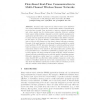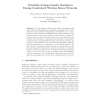EWSN
2009
Springer
15 years 12 days ago
2009
Springer
Wireless sensor networks are an important tool for the supervision of cool chains. Previous research with a high number of measurement points revealed spatial temperature deviation...
EWSN
2009
Springer
15 years 12 days ago
2009
Springer
As the number of wireless devices sharing the unlicensed 2.4 GHz ISM band increases, interference is becoming a problem of paramount importance. We experimentally investigate the e...
EWSN
2009
Springer
15 years 12 days ago
2009
Springer
We consider the problem of cooperative intrusion detection in wireless sensor networks where the nodes are equipped with local detector modules and have to identify the intruder in...
EWSN
2009
Springer
15 years 12 days ago
2009
Springer
Sensor sleeping is a widely-used and cost-effective technique to save energy in wireless sensor networks. Protocols at different stack levels can, either individually or simultaneo...
EWSN
2009
Springer
15 years 12 days ago
2009
Springer
Abstract. The need of monitoring people, animals, and things in general, brings to consider mobile WSNs besides traditional, fixed ones. Moreover, several advanced scenarios, like ...
EWSN
2009
Springer
15 years 12 days ago
2009
Springer
The problem of configuration of Wireless Sensor Networks is an interesting challenge. The objective is to find the settings, for each sensor node, that optimise certain task-level ...
EWSN
2009
Springer
15 years 12 days ago
2009
Springer
As many radio chips used in today's sensor mote hardware can work at different frequencies, several multi-channel communication protocols have recently been proposed to improv...
EWSN
2009
Springer
15 years 12 days ago
2009
Springer
The low quality of wireless links leads to perpetual packet losses. While an acknowledgment mechanism is generally used to cope with these losses, multiple retransmissions neverthe...
EWSN
2009
Springer
15 years 12 days ago
2009
Springer
Abstract. This paper investigates postmortem timestamp reconstruction in environmental monitoring networks. In the absence of a timesynchronization protocol, these networks use mul...
EWSN
2009
Springer
15 years 12 days ago
2009
Springer
Abstract. In-network data aggregation is widely recognized as an acceptable means to reduce the amount of transmitted data without adversely affecting the quality of the results. T...




